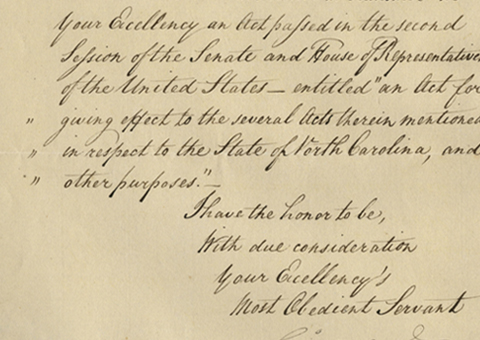Sold – General Logan’s Original Letter of Resignation at the Close of the Civil War

Along with his official certificates of election to Congress.
A U.S. Congressman from southern Illinois and a Stephen A. Douglas Democrat, when the war broke out, Logan took a firm stance for the Union that helped reconcile his part of the state to the conflict. He then volunteered for the war, serving in eight major campaigns. He fought at the Battle...
A U.S. Congressman from southern Illinois and a Stephen A. Douglas Democrat, when the war broke out, Logan took a firm stance for the Union that helped reconcile his part of the state to the conflict. He then volunteered for the war, serving in eight major campaigns. He fought at the Battle of Bull Run, then returned to Illinois to become colonel in the 31st Illinois Regiment. For service at Fort Donelson, he was promoted to brigadier-general, and after distinguishing himself at Vicksburg, was named major-general. He took part in the Atlanta campaign and eventually became commander of the Army of the Tennessee, holding that position twice. Many historians consider him one of the premier volunteer generals of the Civl War. In August 1865, the war over, Logan resigned from the Union Army. This is his actual letter of resignation.
Autograph Telegraph Signed on Illinois & Mississippi Telegraph Company letterhead, Carbondale, Illinois, August 14, 1865, to Secretary of War Edwin M. Stanton. “I hereby tender my resignation as major general of volunteers, and ask as a favor to me it be accepted, there being no necessity for my services longer. It is important to me that I be permitted to resign. If I am not allowed to do so, please extend my leave of absence till first of October, matters of pecuniary interest in settling my business of long standing demand my attention. Please answer me at once at this place.” This is the original telegram in Logan’s hand as retained by him, the text being sent out over the wires.
Stanton responded by telegraph, Washington, August 15, 1865, to Logan. “Your telegram tendering the resignation of your commission in the military service was received this morning and submitted to the President, who directs me to say that it is accepted. Allow me to express my regret that the service will lose so gallant & patriotic a soldier, and to express to you the thanks of the department for the distinguished service you have rendered your country in its hour of trial.” This is the copy received by Logan, and although drafted by Stanton, is in the hand of the telegrapher at the receiving station.
In 1867, Logan returned to Congress, serving two terms in the House followed by two in the Senate. He was also three times elected Commander-in-Chief of the Grand Army of the Republic (GAR). On May 5, 1868, he issued General Order Number 11 which established Memorial Day. In 1884, Logan was James G. Blaine’s vice-presidential running mate.
There are three documents in the group certifying Logan’s elections to Congress. The first, dated February 4, 1861, and signed and sealed with the state seal by Illinois Secretary of State O.M. Hatch, officially informs Logan that he “was duly elected a member of the 37th Congress of the United States, from the 9th Congressional District…” Similar certificates dated September 14, 1866 and December 2, 1870 state that he has been elected a member at large from Illinois to the 40th and 42nd Congresses, respectively. The 1866 document is signed and sealed by Lincoln associate Illinois Governor Richard J. Oglesby and the 1870 one by Governor John M. Palmer. These are the only certifications to Congress that we have ever carried. Also included are two CDVs of Logan in uniform.

Frame, Display, Preserve
Each frame is custom constructed, using only proper museum archival materials. This includes:The finest frames, tailored to match the document you have chosen. These can period style, antiqued, gilded, wood, etc. Fabric mats, including silk and satin, as well as museum mat board with hand painted bevels. Attachment of the document to the matting to ensure its protection. This "hinging" is done according to archival standards. Protective "glass," or Tru Vue Optium Acrylic glazing, which is shatter resistant, 99% UV protective, and anti-reflective. You benefit from our decades of experience in designing and creating beautiful, compelling, and protective framed historical documents.
Learn more about our Framing Services






































































































